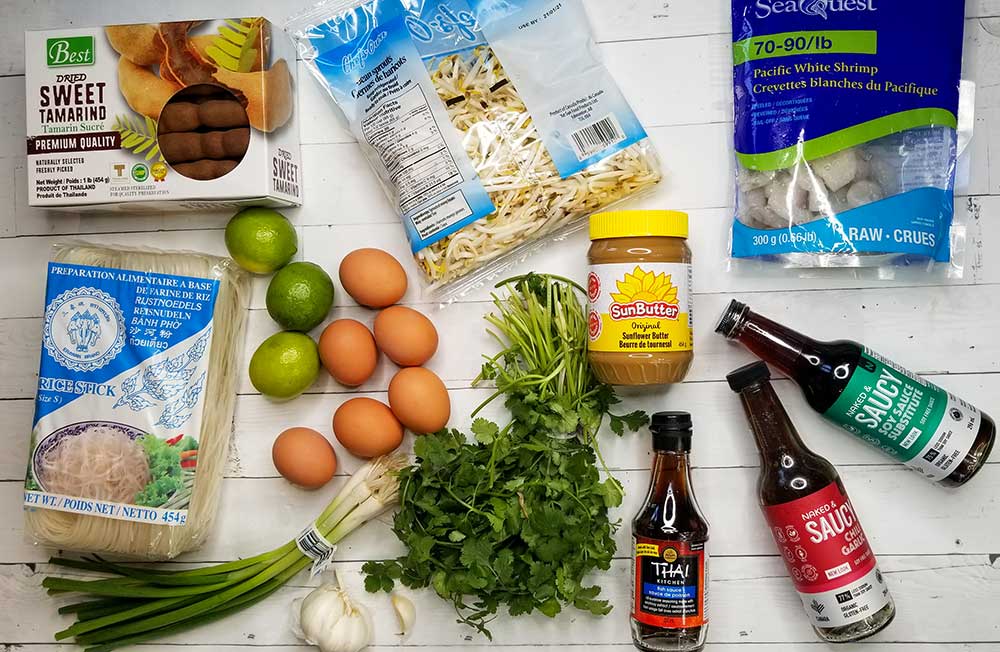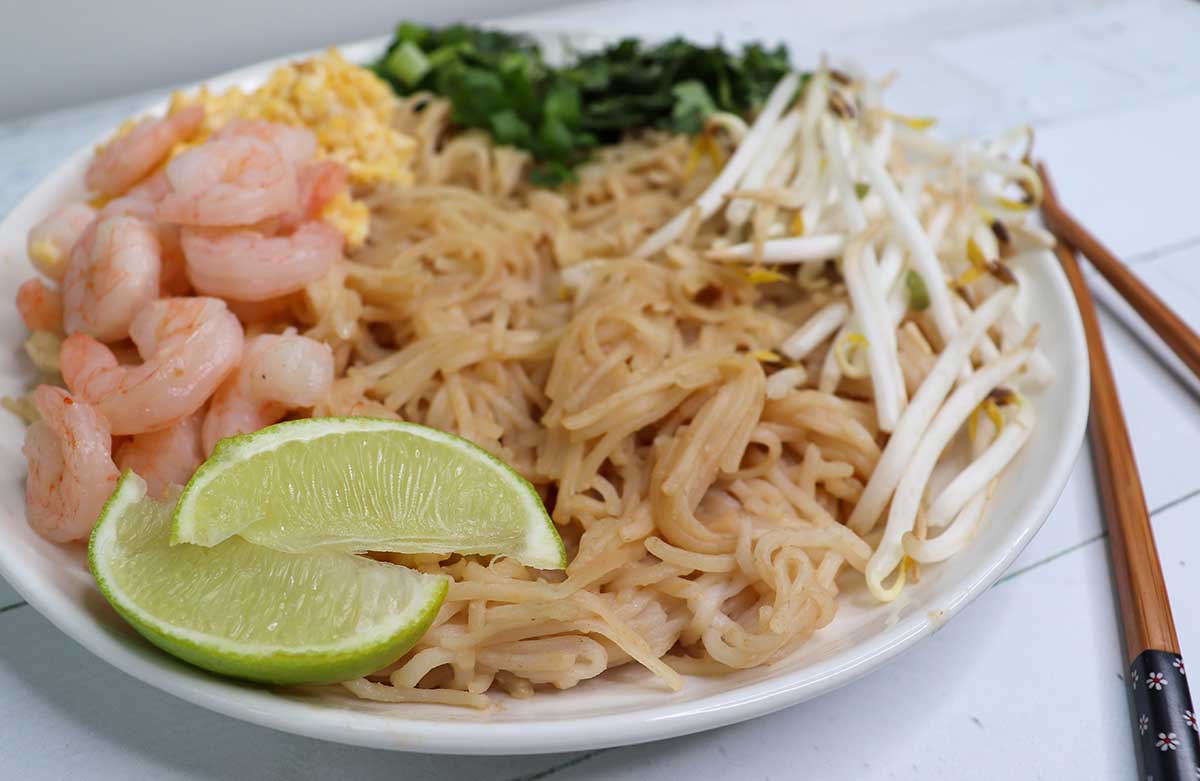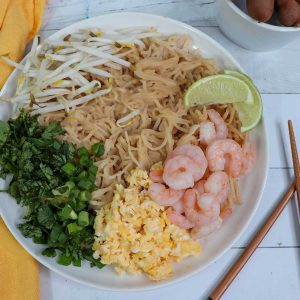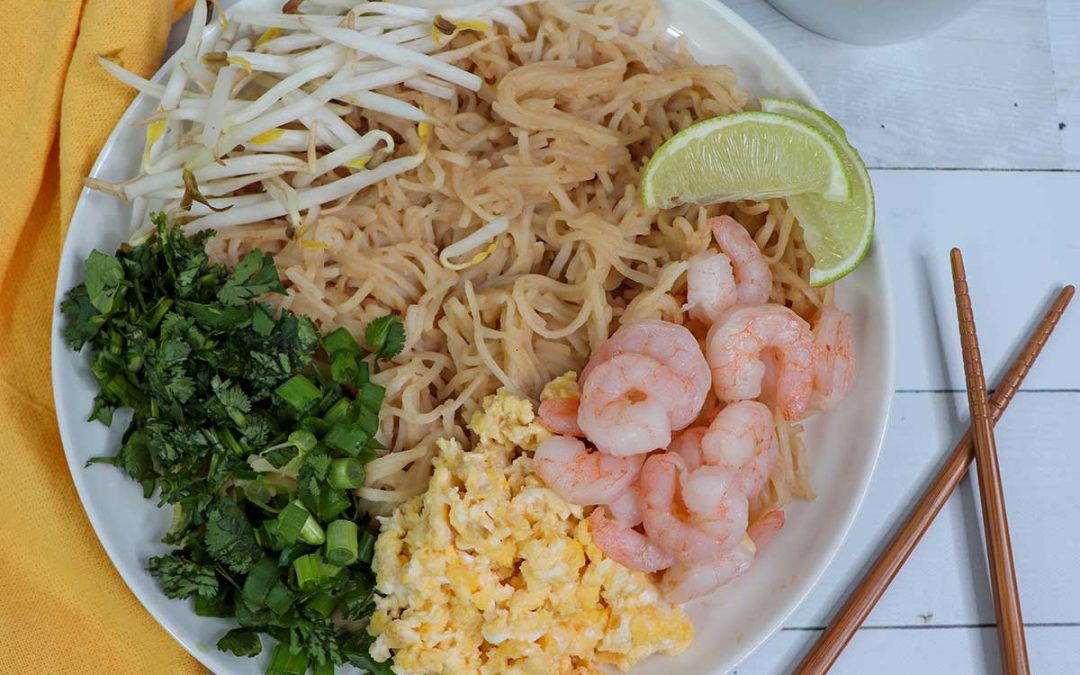In this recipe you’ll make pad thai from scratch, as well as the tamarind paste that serves as the base for the pad thai sauce.
Many people wonder, is pad thai gluten free? It can appear so because it’s usually made with rice noodles. However, pad thai recipes often call for soy sauce and most soy sauces contain gluten.
To ensure this pad thai recipe is actually gluten free, this recipe calls for coconut aminos which is a gluten and soy free alternative to soy sauce. Coconut aminos looks and tastes pretty much identical to soy sauce but is made from the fermented sap of coconut palm.
I’ve also removed peanuts from this recipe and replaced them with sunflower butter to make the recipe even more allergy friendly.
This isn’t exactly traditional pad thai like they serve in Thai restaurants but it’s still delicious.
This recipe is also dairy, peanut AND soy free! And I have provided recipe substitutions and variations below to make this recipe vegan, paleo, keto and lower oxalate.
Product brands I recommend for this recipe

Recipe substitutions
Tamarind paste substitutions: If you don’t want to spend the time making your own tamarind paste, or are not able to find whole dried tamarind at the grocery store (try your local asian markets), you can swap it out for store-bought tamarind paste. Keep in mind though that the store-bought stuff will be more concentrated and strong so start small and work your way up.
Coconut aminos substitutions: If you don’t have or aren’t able to access coconut aminos, you can swap this out for a gluten-free soy sauce / tamari but it wont be soy free then.
Chili sauce substitutions: I like to use the Naked & Saucy brand of chili garlic sauce because it has super clean ingredients. But if you can’t find this, any other chili garlic sauce will do. Just make sure that it is labelled gluten-free.
Egg substitutions: If you can’t do eggs, you can swap them out for an egg free alternative. You can find these in the refrigerated section of your local grocery store. Or you can swap it out for tofu chunks. Or just omit the eggs altogether.
Green onion substitutions: Instead of fresh green onions, swap it out for fresh chives. Because this is a garnish, I don’t suggest using freeze-dried or dried green onions or chives.
Garlic powder substitutions: Instead of garlic powder, swap it out for fresh garlic cloves.
Sunflower seed butter substitutions: If you don’t have an allergy to peanuts, you can swap this out for regular peanut butter. Or alternatively you could use any other nut butter such as almond butter, cashew butter etc. Lastly, if you want to keep things simple, instead of making the sauce, you can buy authentic pad thai sauce or peanut sauce – just make sure it’s labelled gluten-free.
Coconut oil substitutions: You can swap out the coconut oil for any other type of oil or vegan butter.
Protein substitutions: The protein in this recipe is provided by the eggs and shrimp but you can use any type of protein you like such as chicken breasts, pork or beef.
Rice noodle substitutions: Instead of the usual white rice noodles, you can use brown rice noodles, or flat rice noodles. Just make sure to prepare them as per package directions. Instead of using hot water to soak your noodles, you can also try using hot chicken broth to inject some extra flavor into the noodles as well.
Recipe variations
Make chicken pad thai: Simply swap out the shrimp for the same amount of chicken breast or chicken thigh meat.
Switch up the spices and veggies: In addition to what’s below, feel free to add any of the following: oyster sauce, brown sugar, maple syrup, red pepper flakes, chili powder, red bell pepper, black pepper, mung bean sprouts, etc.
Make your pad thai sweeter: If you want this tangy sauce to be a bit sweeter, consider adding a small amount of coconut palm sugar, brown sugar, or any other sweetener of choice.

Dietary modifications
Make this recipe vegan: Omit the eggs, fish sauce, and shrimp. Add things like oyster mushrooms to replace the meat! Voila! Easy vegan pad thai.
Make this recipe low oxalate: This recipe is already fairly low oxalate but if you want to go even lower, swap out the garlic powder for fresh garlic and omit the chili garlic sauce. I haven’t been able to find out whether tamarind is high or low oxalate, so if you know please advise me!
Make this recipe paleo/keto: To make this recipe grain free and lower in carbohydrates, swap out the rice noodles for any type of grain free alternatives such as shirataki noodles, zucchini noodles or simply use the bean sprouts as your noodle base.
Storage tips
Store your left over noodles and meat in an airtight container in the fridge. I would recommend eating them up within a day or two because pasta can get quite soggy if it sits for too long. Freezing the meat and noodles also works.
Keep all of the fresh ingredients in a separate container such as the cilantro, green onions, and bean sprouts. These do not freeze well.
Freeze the rest of your tamarind paste and/or pad thai sauce in a mason jar or airtight container in the freezer for much longer
Recipe FAQs
Is tamarind paste gluten-free?
This homemade recipe for tamarind paste only contains whole dried tamarind and water, making it gluten-free. I cannot vouch for other premade store-bought tamarind paste though so if you are buying it from the store, be sure to check the ingredients ahead of time.
Are pad thai noodles gluten-free?
Pad thai noodles are made from white rice and are therefore gluten-free. Make sure to check the ingredients label though before you purchase it just to be sure.
What are the ingredients in tamarind paste?
In this recipe for tamarind paste, the only ingredients are whole dried tamarinds and water. If you are buying store-bought tamarind paste it may have more ingredients than this. So just make sure to check the ingredients and allergy warnings on the back if you are going to use store-bought.
How do you make tamarind paste at home?
Making tamarind paste from dried tamarind is super easy. I provide more detailed instructions below in the recipe card but basically all you have to do is de-shell the tamarind, put them in about 2 cups of boiling water, and wait 20 minutes. Then squish them around with your hands until it starts getting thicker, and then put it through a fine strainer. That’s it!
Tried my gluten free pad thai dish?
Please leave me a rating and review below, and post a picture of the dish to Instagram and tag me at @foodsnfeels 🙌
You might also like
If you liked this recipe, check out my other Thai recipes:
If you are looking for more recipes, download my free 7 day gluten & dairy free meal plan!

Gluten Free Pad Thai Recipe (Soy & Peanut Free)
Equipment
Ingredients
Tamarind paste
- 1 box whole dried tamarind
- 2 cups boiling water
Pad thai sauce
- 1 cup fresh tamarind paste (See directions)
- 2 tbsp lime juice
- 1 tbsp Naked chili garlic sauce
- 1/4 cup fish sauce
- 1/4 cup coconut aminos
- 1/4 cup sunflower butter
- 1 tsp garlic powder
Pad thai ingredients
- 1 bunch fresh cilantro
- 1 bunch green onions (spring onions)
- 1 bag bean sprouts
- 2 tbsp coconut oil
- 6 eggs
- 1 bag shrimp (thawed)
- 450 g rice noodles
- 1 tsp salt
- 2 limes (for garnish)
Instructions
Tamarind paste
- De-shell the tamarind and pull off all the little stringy bits.
- Put the shelled tamarind in 2 cups of boiling water and let them soak for around 20 minutes.
- After 20 minutes have passed, squish them around with your hands until it starts getting thicker and more paste-like. Optionally at this point you can remove the seeds.
- Put the mixture through a fine strainer over a bowl, pushing the paste through to get as much as possible.
- Keep 1 cup out for the recipe and freeze the rest for next time. Or alternatively, you can double the recipe for the pad thai sauce (also doubling the amount of tamarind paste from 1 cup to 2 cups) and then freeze the rest afterwards.
Pad thai sauce
- Add to the tamarind paste the lime juice, chili garlic sauce, fish sauce, coconut aminos, sunflower butter and garlic powder. Mix sauce thoroughly with a fork or mixer.
Main dish
- Chop up the cilantro and green onions and put aside.
- Scramble 6 eggs in a large pan on medium heat with 1 tablespoon of coconut oil. Once done, transfer to a small bowl and set aside.
- Add another 1 tablespoon coconut oil to the pan and add your bag of thawed shrimp making sure to shell/de-vine them.
- Boil a large pot of water and add 1 teaspoon salt. Once the water is boiling add the rice noodles, stirring often until cooked through. If you want your noodles to be al dente, cook them for slightly less time than is indicated on the package. Remove and strain.
- Put the noodles back in the pot.
- Pour 1 cup of the pad thai sauce into the cooked noodles and stir until the sauce is mixed in and distributed evenly.
- Serve your sauced noodles on a plate and then add fresh cilantro, green onions, scrambled eggs, bean sprouts, shrimp and additional lime wedges.
Video
Notes
Nutrition
Disclaimer: This recipe post contains Amazon affiliate links. This means that if you click on a link and make a purchase, I will receive a small commission (at no extra cost to you). This helps support me so that I can continue to put out high quality, free recipes for you guys! Thank you 😁🙌



 Welcome to my blog! I share my *healthified* comfort food recipes that work with a variety of different diet approaches. AND all of my recipes are 100% gluten and dairy free.
Welcome to my blog! I share my *healthified* comfort food recipes that work with a variety of different diet approaches. AND all of my recipes are 100% gluten and dairy free.
Recent Comments